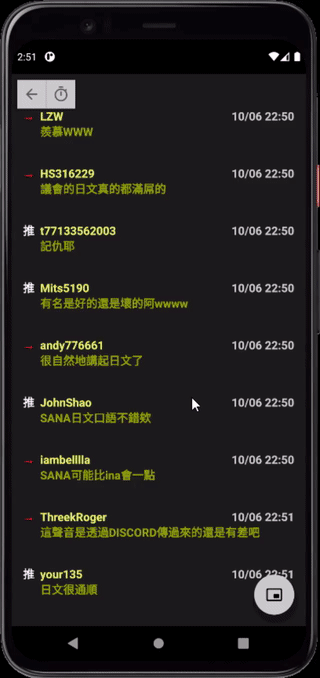懸浮視窗的原理其實很簡單,建立一個背景運作的Service,並且透過WindowManager將自定義的Layout顯示出來。
How to Make a Floating Window Application in Android?
<uses-permission android:name="android.permission.SYSTEM_ALERT_WINDOW" />
<uses-permission android:name="android.permission.FOREGROUND_SERVICE" />
分別是懸浮視窗以及Foreground Service需要的權限
為了確保我們的懸浮視窗能在其他App上層,需要讓使用者另外開啟設定
// 檢查是否已開啟。
private fun checkOverlayDisplayPermission(): Boolean =
Settings.canDrawOverlays(requireContext())
//使用Intent導至設定頁面。
private fun requestOverlayDisplayPermission() {
AlertDialog.Builder(requireContext())
.setCancelable(true)
.setTitle("Screen Overlay Permission Needed")
.setMessage("Enable 'Display over other apps' from System Settings.")
.setPositiveButton("Open Settings") { _, _ ->
val intent = Intent(
Settings.ACTION_MANAGE_OVERLAY_PERMISSION,
Uri.parse("package:${requireContext().packageName}")
)
launcher.launch(intent)
}
.show()
}
Day21加入的popup按鈕的點擊事件
binding.popup.setOnClickListener {
//TODO save search items.
val serviceIntent = Intent(requireActivity(), ObserveService::class.java)
it.context.startForegroundService(serviceIntent)
requireActivity().finish()
}
基本上就是開啟Service並結束MainActivity,TODO的部分是日後要處理的事情,不會在今天的內容中。
使用startForegroundService啟動的話要在Service中建立Notification並使用對應的startForeground方法,這部分已經更新很久就不另外放程式碼了。
<?xml version="1.0" encoding="utf-8"?>
<androidx.constraintlayout.widget.ConstraintLayout xmlns:android="http://schemas.android.com/apk/res/android"
xmlns:app="http://schemas.android.com/apk/res-auto"
android:layout_width="match_parent"
android:layout_height="match_parent"
android:background="@color/background">
<pet.ca.ptttweetsobserver.ControllableRecyclerView
android:id="@+id/recyclerView"
android:layout_width="0dp"
android:layout_height="0dp"
android:background="@color/transparent"
android:padding="@dimen/one_grid_unit"
app:layout_constraintBottom_toBottomOf="parent"
app:layout_constraintEnd_toEndOf="parent"
app:layout_constraintStart_toStartOf="parent"
app:layout_constraintTop_toTopOf="parent" />
<Button
android:id="@+id/resumeUpdate"
android:layout_width="wrap_content"
android:layout_height="wrap_content"
android:layout_marginBottom="@dimen/one_grid_unit"
android:text="自動更新"
android:translationY="200dp"
app:layout_constraintBottom_toBottomOf="parent"
app:layout_constraintEnd_toEndOf="parent"
app:layout_constraintStart_toStartOf="parent" />
<ImageView
android:id="@+id/back"
android:layout_width="wrap_content"
android:layout_height="wrap_content"
android:layout_marginStart="@dimen/one_grid_unit"
android:layout_marginTop="@dimen/one_grid_unit"
android:background="@color/text_normal"
android:clickable="true"
android:elevation="@dimen/half_grid_unit"
android:focusable="true"
android:foreground="?android:attr/selectableItemBackground"
android:padding="@dimen/one_grid_unit"
android:src="@drawable/ic_baseline_fullscreen_24"
app:layout_constraintStart_toStartOf="parent"
app:layout_constraintTop_toTopOf="parent" />
<View
android:id="@+id/divider"
android:layout_width="1dp"
android:layout_height="0dp"
android:background="@color/text_normal"
app:layout_constraintBottom_toBottomOf="@id/back"
app:layout_constraintStart_toEndOf="@id/back"
app:layout_constraintTop_toTopOf="@id/back" />
<ImageView
android:id="@+id/move"
android:layout_width="wrap_content"
android:layout_height="wrap_content"
android:layout_marginTop="@dimen/one_grid_unit"
android:background="@color/text_normal"
android:clickable="true"
android:elevation="@dimen/half_grid_unit"
android:focusable="true"
android:foreground="?android:attr/selectableItemBackground"
android:padding="@dimen/one_grid_unit"
android:src="@drawable/selector_move"
app:layout_constraintStart_toEndOf="@id/divider"
app:layout_constraintTop_toTopOf="parent" />
<View
android:id="@+id/divider2"
android:layout_width="1dp"
android:layout_height="0dp"
android:background="@color/text_normal"
app:layout_constraintBottom_toBottomOf="@id/move"
app:layout_constraintStart_toEndOf="@id/move"
app:layout_constraintTop_toTopOf="@id/move" />
<ImageView
android:id="@+id/resize"
android:layout_width="wrap_content"
android:layout_height="wrap_content"
android:layout_marginTop="@dimen/one_grid_unit"
android:background="@color/text_normal"
android:clickable="true"
android:elevation="@dimen/half_grid_unit"
android:focusable="true"
android:foreground="?android:attr/selectableItemBackground"
android:padding="@dimen/one_grid_unit"
android:src="@drawable/ic_baseline_pinch_24"
app:layout_constraintStart_toEndOf="@id/divider2"
app:layout_constraintTop_toTopOf="parent" />
<ImageView
android:id="@+id/close"
android:layout_width="wrap_content"
android:layout_height="wrap_content"
android:layout_marginTop="@dimen/one_grid_unit"
android:layout_marginEnd="@dimen/one_grid_unit"
android:background="@color/text_normal"
android:clickable="true"
android:elevation="@dimen/half_grid_unit"
android:focusable="true"
android:foreground="?android:attr/selectableItemBackground"
android:padding="@dimen/one_grid_unit"
android:src="@drawable/ic_round_close_24"
app:layout_constraintEnd_toEndOf="parent"
app:layout_constraintTop_toTopOf="parent" />
</androidx.constraintlayout.widget.ConstraintLayout>
預覽畫面
跟Day02的草圖有些差異,目前這邊基本只保留調整外框大小跟位置的按鈕了。
private fun createFloatingWindow() {
val metrics = application.resources.displayMetrics
val width = metrics.widthPixels
val height = metrics.heightPixels
windowManager = getSystemService(WINDOW_SERVICE) as WindowManager
val inflater = getSystemService(LAYOUT_INFLATER_SERVICE) as LayoutInflater
_binding = LayoutObserverBinding.inflate(inflater)
val frameLayoutParams = WindowManager.LayoutParams(
(width * 0.55f).toInt(),
(height * 0.58f).toInt(),
layoutType,
WindowManager.LayoutParams.FLAG_NOT_FOCUSABLE,
PixelFormat.TRANSLUCENT
)
frameLayoutParams.gravity = Gravity.CENTER
frameLayoutParams.x = 0
frameLayoutParams.y = 0
windowManager.addView(binding.root, frameLayoutParams)
}
其實這段沒什麼好說明的,addView後畫面就會顯示出來了。
這部分的內容與Day17、Day19、Day20基本一致,差別只在於目前已經在文章內了,不需要多做進入文章並置底的前置動作。
今天除了建立懸浮視窗,也一併把移動和關閉的功能加入了,退回和修改大小因為我目前想起來比較難一些,預計會放在接下來幾天的內容。
移動按鈕的點擊事件很單純:
binding.move.setOnClickListener {
if (it.isSelected) {
binding.root.setOnTouchListener(null)
} else {
binding.root.setOnTouchListener(onFrameTouchListener)
}
binding.recyclerView.touchable = it.isSelected
it.isSelected = !it.isSelected
}
使用isSelected狀態來判斷目前要切換成哪種模式,在移動模式中加入onFrameTouchListener來處理後續觸控事件。此外由於我們的Layout內有使用RecyclerView,為了避免事件被攔截需要做另外的處理。
自定義一個新的RecyclerView並override dispatchTouchEvent。
class ControllableRecyclerView @JvmOverloads constructor(
context: Context,
attrs: AttributeSet? = null,
defStyleAttr: Int = 0
) : RecyclerView(context, attrs, defStyleAttr) {
var touchable = true
override fun dispatchTouchEvent(ev: MotionEvent?): Boolean {
return (touchable && super.dispatchTouchEvent(ev))
}
}
透過另外設定的touchable變數來判斷是否要在RecyclerView繼續分發事件,return記得一定要包含super.dispatchTouchEvent(ev),否則就算為true也不會將事件繼續分發。
懸浮視窗的移動事件:
private val onFrameTouchListener = View.OnTouchListener { _, motionEvent ->
val params = binding.root.layoutParams as WindowManager.LayoutParams
when (motionEvent.action) {
MotionEvent.ACTION_DOWN -> {
return@OnTouchListener true
}
MotionEvent.ACTION_MOVE -> {
if (motionEvent.historySize < 2) return@OnTouchListener true
val dx = motionEvent.getHistoricalX(1) - motionEvent.getHistoricalX(0)
val dy = motionEvent.getHistoricalY(1) - motionEvent.getHistoricalY(0)
params.x = (params.x + dx).toInt()
params.y = (params.y + dy).toInt()
windowManager.updateViewLayout(binding.root, params)
return@OnTouchListener true
}
}
return@OnTouchListener false
}
透過Move event的HistoricalX及HistoricalY來判斷移動的距離,並更新目前的LayoutParams即可。
目前在模擬器裡面測試起來感覺有點誤差,這部分後日再看看怎麼處理。
binding.close.setOnClickListener {
stopSelf()
PttClient.getInstance().end()
}
首先是使用stopSelf關閉Service,關閉Service會進入onDestroy,在這邊把其他物件給釋放掉。
override fun onDestroy() {
super.onDestroy()
updateHandler.removeCallbacks(updateRunnable)
removeFloatingWindow()
stopForeground(true)
}
接著要記得把PttClient也關掉,關閉連線、stream並釋放singleton的reference。
class PttClient private constructor(serverUri: URI, header: MutableMap<String, String>) :
WebSocketClient(serverUri, Draft_6455(), header) {
// ...
public fun end() {
close()
pipedOutputStream.close()
pipedInputStream.close()
instance = null
}
// ...
}

